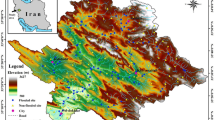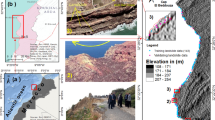Abstract
Landslide susceptibility assessment (LSA) is an essential method to prevent and mitigate landslides. Many studies thus involve the LSA and improve the accuracy of LSA using various methods; however, most of the studies optimize the LSA by improving the evaluation models and neglect the influence of factors. The present study initially selects fifteen factors and combines the optimization algorithms, namely, the genetic algorithm (GA), with entropy theory (ET) to divide the factors. The division results are compared with that of the natural breakpoint method (NBM) and equidistant empirical method (EEM) which are the most commonly used methods. The division results are employed to select factors based on the chi-square test and multicollinearity test, and the optimal number of factors involved in the evaluation and the factor systems are determined by the recursive feature elimination method based on the out-of-bag error. The LSAs of ET-GA, NBM, and EEM are then obtained using improved deep belief networks (DBN), and the distribution patterns of the landslide susceptibility maps are similar. The landslide density of very high susceptibility using the three methods is more than three times that of low susceptibility, which illustrates that the three methods are applicable to LSA in the study area. The assessment results are evaluated by the area under the receiver operating characteristic curve (AUC). The ET-GA showed the highest AUC, proving that the optimization algorithms can improve the accuracy of LSA and the ET-GA is more applicable for LSA in the study area.









Similar content being viewed by others
Data availability
Datasets used in this study are available from the corresponding author on reasonable request.
References
Arora N, Kaur PD (2020) A Bolasso based consistent feature selection enabled random forest classification algorithm: an application to credit risk assessment. Appl Soft Comput 86:105936. https://doi.org/10.1016/j.asoc.2019.105936
Balogun AL, Rezaie F, Pham QB, Gigović L, Drobnjak S, Aina YA, Panahi M, Yekeen ST, Lee S (2021) Spatial prediction of landslide susceptibility in western Serbia using hybrid support vector regression (SVR) with GWO, BAT and COA algorithms. Geosci Front 12:101104. https://doi.org/10.1016/j.gsf.2020.10.009
Bragagnolo L, da Silva RV, Grzybowski JMV (2020a) Landslide susceptibility mapping with r.landslide: a free open-source GIS-integrated tool based on Artificial Neural Networks. Environ Model Softw 123:104565. https://doi.org/10.1016/j.envsoft.2019.104565
Bragagnolo L, Silva RVD, Grzybowski JMV (2020b) Artificial neural network ensembles applied to the mapping of landslide susceptibility. CATENA 184:104240. https://doi.org/10.1016/j.catena.2019.104240
Budimir MEA, Atkinson PM, Lewis HG (2015) A systematic review of landslide probability mapping using logistic regression. Landslides 12:419–436. https://doi.org/10.1007/s10346-014-0550-5
Bui DT, Tsangaratos P, Nguyen VT, Liem NV, Trinh PT (2020) Comparing the prediction performance of a Deep Learning Neural Network model with conventional machine learning models in landslide susceptibility assessment. CATENA 188:104426. https://doi.org/10.1016/j.catena.2019.104426
Chacón J, Irigaray C, Fernández T, El Hamdouni R (2006) Engineering geology maps: landslides and geographical information systems. Bull Eng Geol Env 65:341–411. https://doi.org/10.1007/s10064-006-0064-z
Chen W, Zhang S (2021) GIS-based comparative study of Bayes network, Hoeffding tree and logistic model tree for landslide susceptibility modeling. CATENA 203:105344. https://doi.org/10.1016/j.catena.2021.105344
Dawn Thompson J (2016) 3 - Statistical alignment approaches. in Dawn Thompson. J (ed) Statistics for Bioinformatics Elsevier p. 43–51
Du J, Glade T, Woldai T, Chai B, Zeng B (2020) Landslide susceptibility assessment based on an incomplete landslide inventory in the Jilong Valley, Tibet, Chinese Himalayas. Eng Geol 270:105572. https://doi.org/10.1016/j.enggeo.2020.105572
Fang Z, Wang Y, Peng L, Hong H (2020) Integration of convolutional neural network and conventional machine learning classifiers for landslide susceptibility mapping. Comput Geosci 139:104470. https://doi.org/10.1016/j.cageo.2020.104470
Goyes-Peñafiel P, Hernandez-Rojas A (2021) Landslide susceptibility index based on the integration of logistic regression and weights of evidence: a case study in Popayan, Colombia. Eng Geol 280:105958. https://doi.org/10.1016/j.enggeo.2020.105958
Guyon I, Weston J, Barnhill S, Vapnik V (2002) Gene selection for cancer classification using support vector machines. Mach Learn 46:389–422. https://doi.org/10.1023/A:1012487302797
Guzzetti F, Reichenbach P, Cardinali M, Galli M, Ardizzone F (2005) Probabilistic landslide hazard assessment at the basin scale. Geomorphology 72:272–299. https://doi.org/10.1016/j.geomorph.2005.06.002
Hong H, Tsangaratos P, Ilia I, Loupasakis C, Wang Y (2020) Introducing a novel multi-layer perceptron network based on stochastic gradient descent optimized by a meta-heuristic algorithm for landslide susceptibility mapping. Science of The Total Environment 742:140549. https://doi.org/10.1016/j.scitotenv.2020.140549
Hu Q, Zhou Y, Wang S, Wang F (2020) Machine learning and fractal theory models for landslide susceptibility mapping: case study from the Jinsha River Basin. Geomorphology 351:106975. https://doi.org/10.1016/j.geomorph.2019.106975
Huabin W, Gangjun L, Weiya X, Wang G (2005) GIS-based landslide hazard assessment: an overview. Progress in Physical Geography - PROG PHYS GEOG 29:548–567. https://doi.org/10.1191/0309133305pp462ra
Lei X, Chen W, Pham B (2020) Performance evaluation of GIS-based artificial intelligence approaches for landslide susceptibility modeling and spatial patterns analysis. ISPRS Int J Geo Inf 9:443. https://doi.org/10.3390/ijgi9070443
Li J, Wang W, Han Z (2021) A variable weight combination model for prediction on landslide displacement using AR model, LSTM model, and SVM model: a case study of the Xinming landslide in China. Environmental Earth Sciences 80:386. https://doi.org/10.1007/s12665-021-09696-2
Lugo Reyes SO (2020) Chapter 21 - Artificial intelligence in precision health: systems in practice. in Barh, D (ed) Artificial Intelligence in Precision Health, Academic Press, p. 499–519
Mandal K, Saha S, Mandal S (2021) Applying deep learning and benchmark machine learning algorithms for landslide susceptibility modelling in Rorachu river basin of Sikkim Himalaya, India. Geosci Front 12: https://doi.org/10.1016/j.gsf.2021.101203
Merghadi A, Yunus AP, Dou J, Whiteley J, ThaiPham B, Bui DT, Avtar R, Abderrahmane B (2020) Machine learning methods for landslide susceptibility studies: a comparative overview of algorithm performance. Earth-Scie Rev 207:103225. https://doi.org/10.1016/j.earscirev.2020.103225
Nhu V-H, Shirzadi A, Shahabi H, Chen W, Clague J, Geertsema M, Jaafari A, Avand M, Miraki S, Asl D, Pham B, Bin B, Ahmad LS (2020) Shallow landslide susceptibility mapping by random forest base classifier and its ensembles in a semi-arid region of Iran. Forests 11:421. https://doi.org/10.3390/f11040421
Peethambaran B, Anbalagan R, Kanungo DP, Goswami A, Shihabudheen KV (2020) A comparative evaluation of supervised machine learning algorithms for township level landslide susceptibility zonation in parts of Indian Himalayas. CATENA 195:104751. https://doi.org/10.1016/j.catena.2020.104751
Pham BT, Nguyen-Thoi T, Qi C, Phong TV, Dou J, Ho LS, Le HV, Prakash I (2020) Coupling RBF neural network with ensemble learning techniques for landslide susceptibility mapping. CATENA 195:104805. https://doi.org/10.1016/j.catena.2020.104805
Pham BT, Tien BD, Prakash I, Dholakia MB (2017) Hybrid integration of Multilayer Perceptron Neural Networks and machine learning ensembles for landslide susceptibility assessment at Himalayan area (India) using GIS. CATENA 149:52–63. https://doi.org/10.1016/j.catena.2016.09.007
Reichenbach P, Rossi M, Malamud BD, Mihir M, Guzzetti F (2018) A review of statistically-based landslide susceptibility models. Earth Sci Rev 180:60–91. https://doi.org/10.1016/j.earscirev.2018.03.001
Saha S, Arabameri A, Saha A, Blaschke T, Ngo PTT, Nhu VH, Band SS (2021) Prediction of landslide susceptibility in Rudraprayag, India using novel ensemble of conditional probability and boosted regression tree-based on cross-validation method. Sci Total Environ 764:142928. https://doi.org/10.1016/j.scitotenv.2020.142928
Sahin EK, Colkesen I, Acmali SS, Akgun A, Aydinoglu AC (2020) Developing comprehensive geocomputation tools for landslide susceptibility mapping: LSM tool pack. Comput Geosci 144:104592. https://doi.org/10.1016/j.cageo.2020.104592
Shafizadeh-Moghadam H, Valavi R, Shahabi H, Chapi K, Shirzadi A (2018) Novel forecasting approaches using combination of machine learning and statistical models for flood susceptibility mapping. J Environ Manage 217:1–11. https://doi.org/10.1016/j.jenvman.2018.03.089
Shannon CE (1948) A mathematical theory of communication. Bell Syst Tech J 27:379–423. https://doi.org/10.1002/j.1538-7305.1948.tb01338.x
Simoncini D, Zhang KYJ (2019) Population-based sampling and fragment-based de novo protein structure prediction. In: Gribskov M, Nakai K, Schönbach C (eds) Ranganathan, S. Oxford, Academic Press, Encyclopedia of bioinformatics and computational biology, pp 774–784
Sujatha ER, Sridhar V (2019) Mapping of erosion susceptibility using a weighted linear combination model: a case study of a hill sub-watershed in Kodaikkanal, Western Ghats, South India. Remote Sensing Applications: Society and Environment 14:34–45. https://doi.org/10.1016/j.rsase.2019.02.004
Sun D, Wen H, Wang D, Xu J (2020) A random forest model of landslide susceptibility mapping based on hyperparameter optimization using Bayes algorithm. Geomorphology 362:107201. https://doi.org/10.1016/j.geomorph.2020.107201
Tanyu BF, Abbaspour A, Alimohammadlou Y, Tecuci G (2021) Landslide susceptibility analyses using Random Forest, C4.5, and C5.0 with balanced and unbalanced datasets. CATENA 203:105355. https://doi.org/10.1016/j.catena.2021.105355
Thi Ngo PT, Panahi M, Khosravi K, Ghorbanzadeh O, Kariminejad N, Cerda A, Lee S (2021) Evaluation of deep learning algorithms for national scale landslide susceptibility mapping of Iran. Geosci Front 12:505–519. https://doi.org/10.1016/j.gsf.2020.06.013
Urso A, Fiannaca A, La Rosa M, Ravì V, Rizzo R (2019) Data mining: prediction methods. In: Gribskov M, Nakai K, Schönbach C (eds) Ranganathan, S. Oxford, Academic Press, Encyclopedia of bioinformatics and computational biology, pp 413–430
Wang C, Pan Y, Chen J, Ouyang Y, Rao J, Jiang Q (2020a) Indicator element selection and geochemical anomaly mapping using recursive feature elimination and random forest methods in the Jingdezhen region of Jiangxi Province, South China. Appl Geochem 122:104760. https://doi.org/10.1016/j.apgeochem.2020.104760
Wang W-D, Li J, Han Z (2020b) Comprehensive assessment of geological hazard safety along railway engineering using a novel method: a case study of the Sichuan-Tibet railway, China. Geomat Nat Haz Risk 11:1–21. https://doi.org/10.1080/19475705.2019.1699606
Wang W, Li J, Qu X, Han Z, Liu P (2019) Prediction on landslide displacement using a new combination model: a case study of Qinglong landslide in China. Nat Hazards 96:1121–1139. https://doi.org/10.1007/s11069-019-03595-3
Wang X, Liu J, Hou T, Pan C (2021) The SSA-BP-based potential threat prediction for aerial target considering commander emotion. Defence Technology. https://doi.org/10.1016/j.dt.2021.05.017
Wang Y, Fang Z, Wang M, Peng L, Hong H (2020c) Comparative study of landslide susceptibility mapping with different recurrent neural networks. Comput Geosci 138:104445. https://doi.org/10.1016/j.cageo.2020.104445
Zhang C, Ding S (2021) A stochastic configuration network based on chaotic sparrow search algorithm. Knowledge-Based Systems 220:106924. https://doi.org/10.1016/j.knosys.2021.106924
Zhao Y, Wang R, Jiang Y, Liu H, Wei Z (2019) GIS-based logistic regression for rainfall-induced landslide susceptibility mapping under different grid sizes in Yueqing, Southeastern China. Eng Geol 259:105147. https://doi.org/10.1016/j.enggeo.2019.105147
Zhou Q, Zhou H, Zhou Q, Yang F, Luo L (2014) Structure damage detection based on random forest recursive feature elimination. Mech Syst Signal Process 46:82–90. https://doi.org/10.1016/j.ymssp.2013.12.013
Zhou X, Wen H, Zhang Y, Xu J, Zhang W (2021) Landslide susceptibility mapping using hybrid random forest with GeoDetector and RFE for factor optimization. Geosci Front 12:101211. https://doi.org/10.1016/j.gsf.2021.101211
Acknowledgements
This study was financially supported by the National Natural Science Foundation of China (Grant No. 51478483, W. Wang) and the China Scholarship Council. The financial supports are gratefully acknowledged.
Author information
Authors and Affiliations
Corresponding author
Rights and permissions
Springer Nature or its licensor (e.g. a society or other partner) holds exclusive rights to this article under a publishing agreement with the author(s) or other rightsholder(s); author self-archiving of the accepted manuscript version of this article is solely governed by the terms of such publishing agreement and applicable law.
About this article
Cite this article
Li, J., Wang, W., Chen, G. et al. Secondary-factor division optimization based on ET-GA to improve the accuracy of LSA obtained using SSA-DBN compared to the original division method: a case study in southern Sichuan, China. Bull Eng Geol Environ 82, 325 (2023). https://doi.org/10.1007/s10064-023-03331-z
Received:
Accepted:
Published:
DOI: https://doi.org/10.1007/s10064-023-03331-z




